Carrying Cases
It is hard to imagine the world without carrying cases. They are put to use every day in a massive variety of ways. They get our stuff from point A to point B without damage. When they fail, we are at a loss, whether financial, material, or for kind words. With the ability to purchase or customize a quality case for nearly any purpose, getting things where they need to be, intact, is no longer a gamble.
Carrying cases come in many shapes, sizes, and compositions. They are often rectangular, sometimes with recesses or pockets to secure items. They may be tubes with sealed end caps and/ or hinged sides. They may be internally or externally shaped to the contours of the things inside. Carrying cases may be flame retardant, static free, resistant to electromagnetic interference, or waterproof. They may be hard or soft sided, single chambered or compartmentalized, and may have wheels for ease of movement.
More than just boxes and bags, custom carrying cases provide quality protection for the safe transport of delicate, sensitive, unruly, or potentially dangerous items, equipment, or materials. The case size, shape, and composition will be dependent upon the material in transit.
Quick links to Carrying Cases Information
Bagging and Boxing Up History
The first carrying cases made to be sold were limp sacks with handles called satchels. In 1826, Godillot of Paris was the first person to patent a bag with a hinged iron frame. The advent of his "carpet bag" heralded the birth of the luggage industry. As transportation developed, so did the need for more robust containers to transport personal belongings.
The 1850s saw the development of the briefcase, a rectangular case designed to hold business papers. This allowed businessmen to carry important paperwork inside a portable desk.
Heavy, curved topped steamer trunks made from wood and iron were made for carrying clothes and personal items, onboard ships and trains, into the industrial revolution. They were waterproofed by coating the outside with sap.
Louis Vuitton created a slatted trunk with canvas sheathing on the outside and drawers inside. His cases had flat tops, for stackability. The design and the brand are still popular today.
The handling of these trunks was typically left to servants and porters. As more common people, without hired help, began to travel by stagecoach and, eventually, automobiles, lightweight, sturdy bags became necessary. The late 19th century saw a trend toward leather luggage. 1897 saw the first advertisement for a "suit case".
By the 1930s, air travel was becoming common practice. The need for lightweight cases to contain all sorts of items was growing. In 1950, the Rimowa company in Germany designed the first aircraft aluminum case. Models being manufactured today remain similar to the 1952 designs. You can find a list of manufacturers of them here on IQS Directory.
The 1960s ushered in the use of wheeled trolleys to move baggage through airports and train stations. In 1972, Bernard Sadow obtained the first U.S. patent for "Rolling Luggage". The concept was seized upon, and within two years, several companies were marketing their own version, revolutionizing modern travel and transport of fragile goods.
The Rimowa Company introduced the first polycarbonate luggage in 2000. It proved to be lighter and more durable than metal cases.
In 2004, the Samsonite company presented The Spinner, a wheeled suitcase that can be pushed, pulled, or spun in any direction, making airport navigation easy and convenient.
Uses for Carrying Cases
Papers are kept dry and in order in plastic cases, briefcases, or portfolios. Musical instruments, electronic equipment, medical instruments, and chemicals are protected from shock, moisture, or drastic temperature changes by waterproof cases with custom foam interiors, made to accommodate safe transport. Anti-static foam may be used inside the protective case to safeguard electronic equipment from static discharge during transit. You can find companies who manufacture this foam here on IQS Directory.
Sewing notions, beads, and other small craft accessories need to be contained in segregated compartments. There are plastic carry cases for appropriate and convenient storage and transport of these items.
Many tool sets for hobbyists, construction workers, and mechanics are packaged in form-fitted carry cases that make them easy to keep organized. There are apparatus specific cases for computers, archery, fishing, golf, photography, makeup, and art supplies. Firearms require specially made, locking gun cases for commercial or private transport.
Some carry cases double as display cases for trade shows and sales presentations, such as the ones you can find here. Heavy duty, rolling cases for speakers, lighting, and sound equipment, provide entertainers and production crews the ability to take their show on the road. Sturdy cases for transporting medical equipment and supplies allow doctors to access sick and injured people in remote places and adverse conditions.Road cases are a type of carrying case used to protect sensitive equipment as you carry them in transit.
Carrying Case Images, Diagrams and Visual Concepts
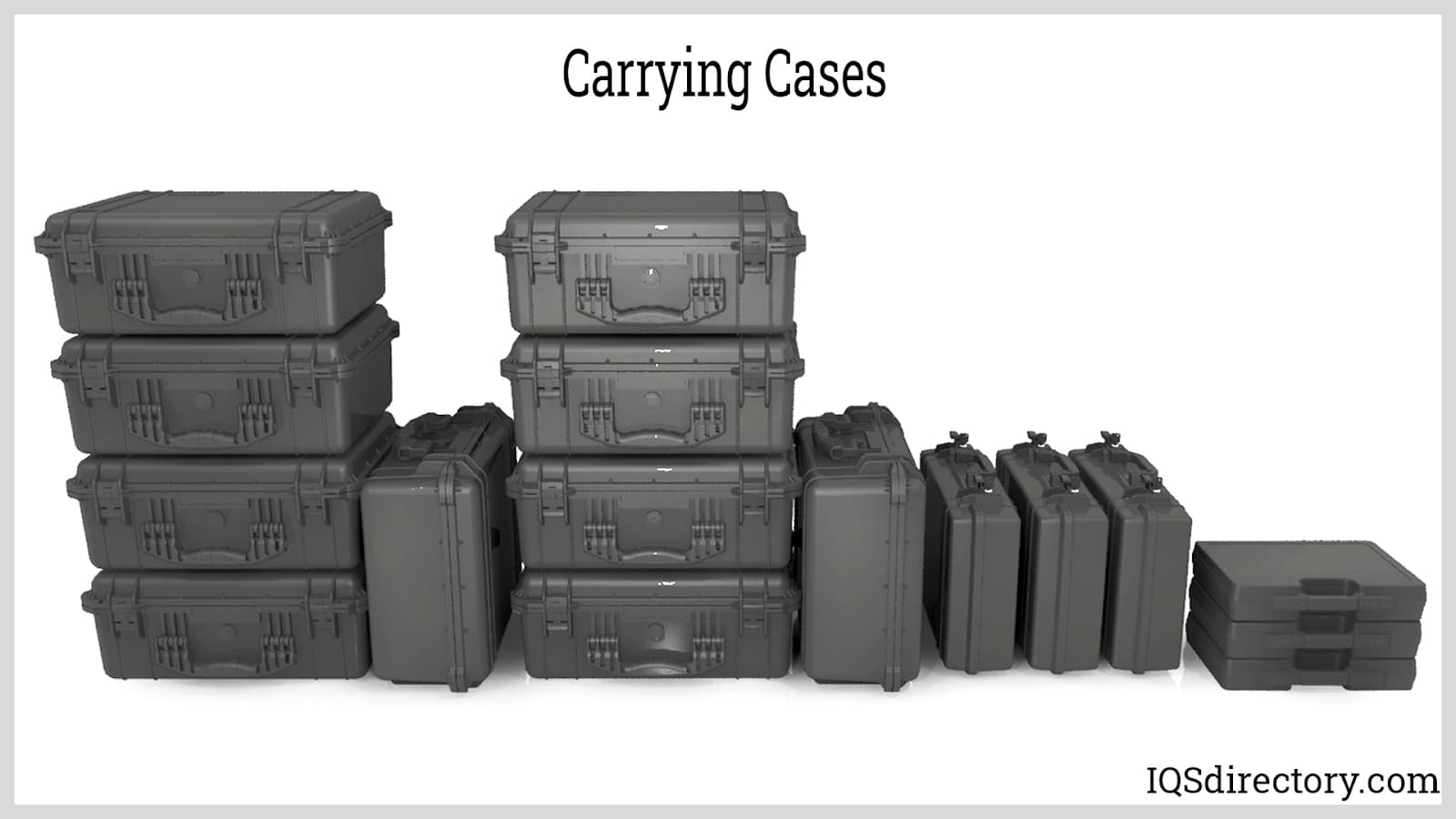 Carrying cases are a way of organizing and transporting a collection of similar or dissimilar items.
Carrying cases are a way of organizing and transporting a collection of similar or dissimilar items.
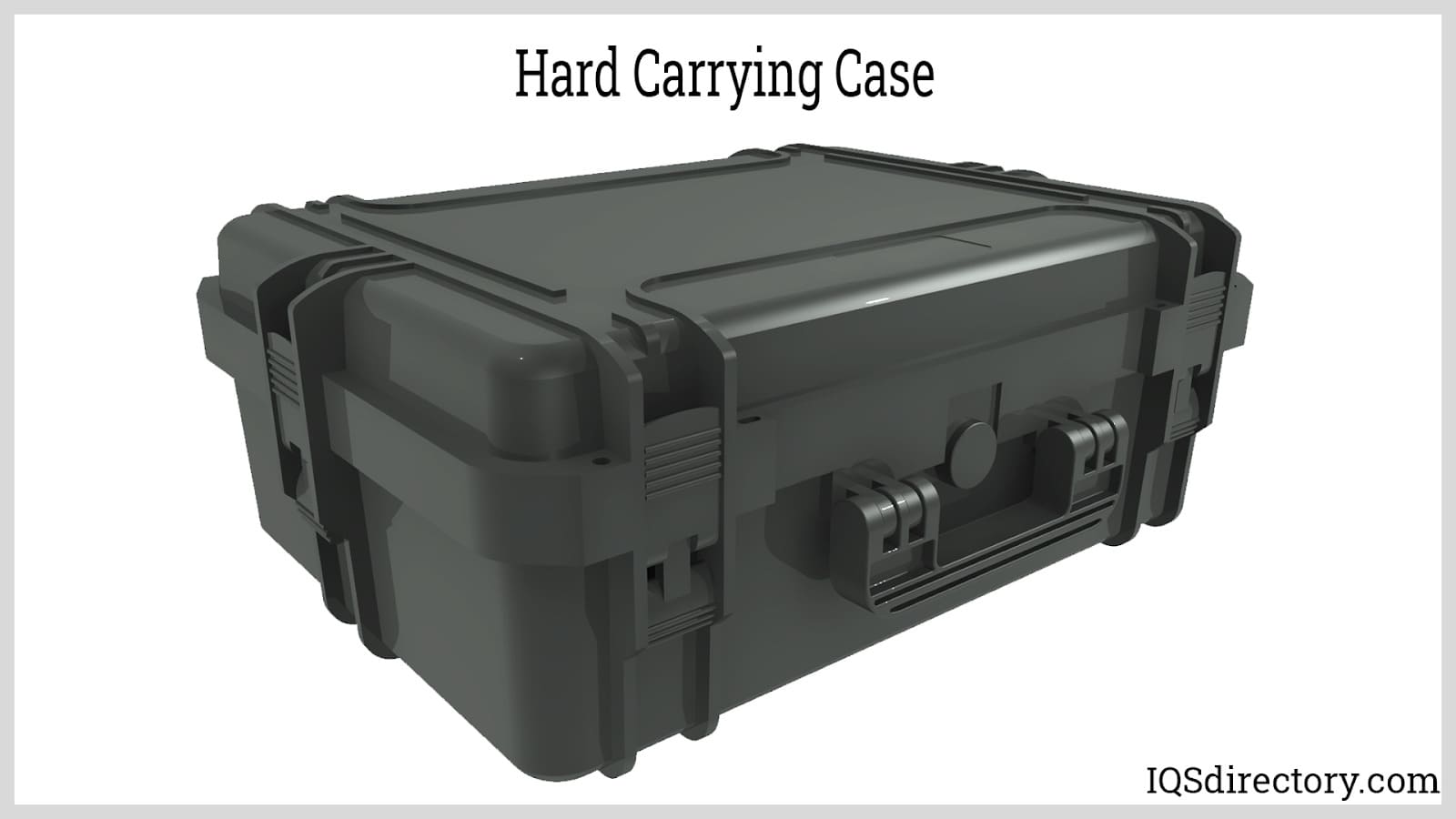 A hard case is a type of carrying case that is made from molded plastic, aluminum, laminated wood, or different types of metals which are the most secure and durable forms of carrying cases.
A hard case is a type of carrying case that is made from molded plastic, aluminum, laminated wood, or different types of metals which are the most secure and durable forms of carrying cases.
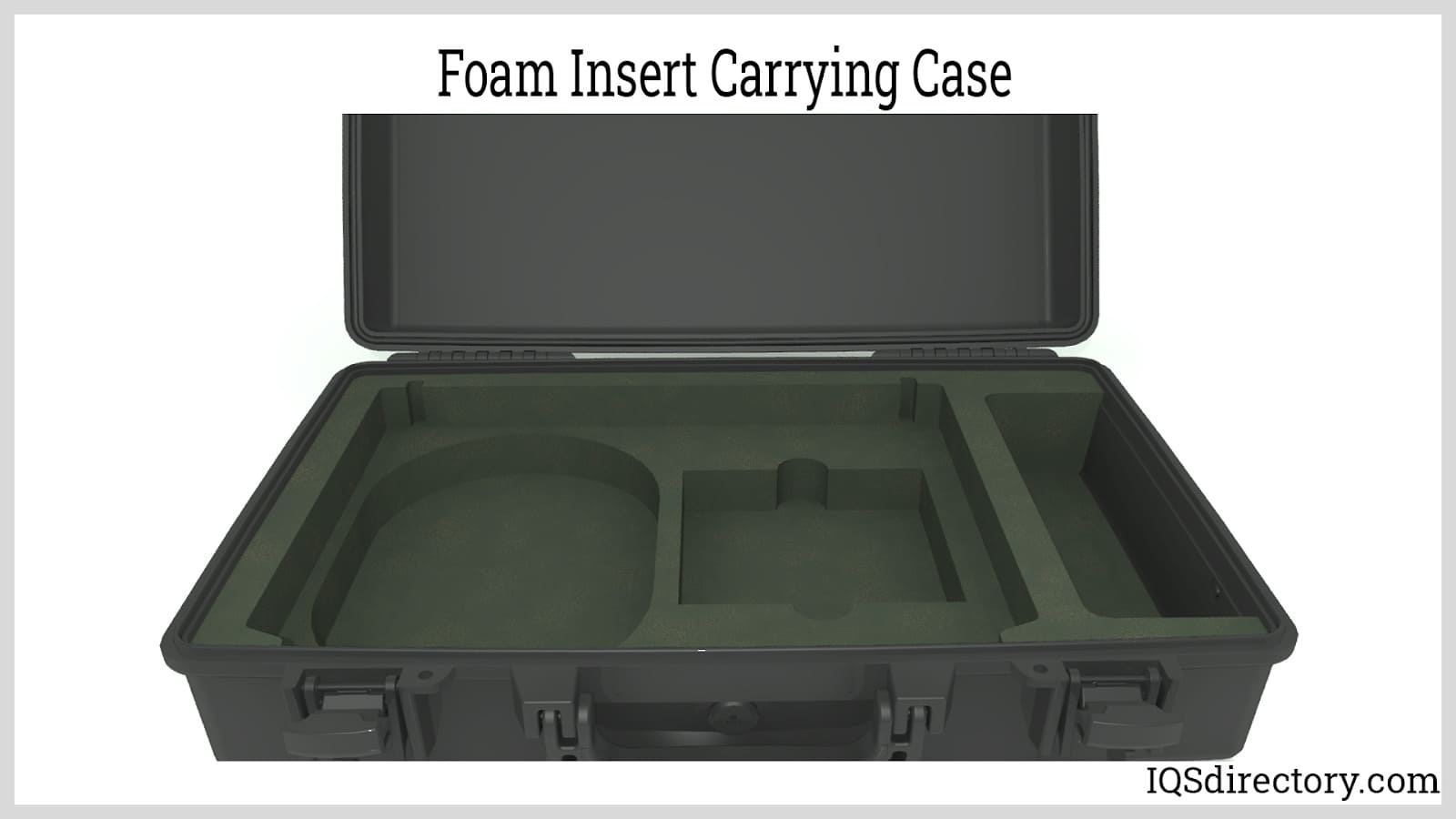 Foam insert carrying cases are like divider cases, that are divided into sections using soft foam material which is cut to the exact shape of the items to be carried.
Foam insert carrying cases are like divider cases, that are divided into sections using soft foam material which is cut to the exact shape of the items to be carried.
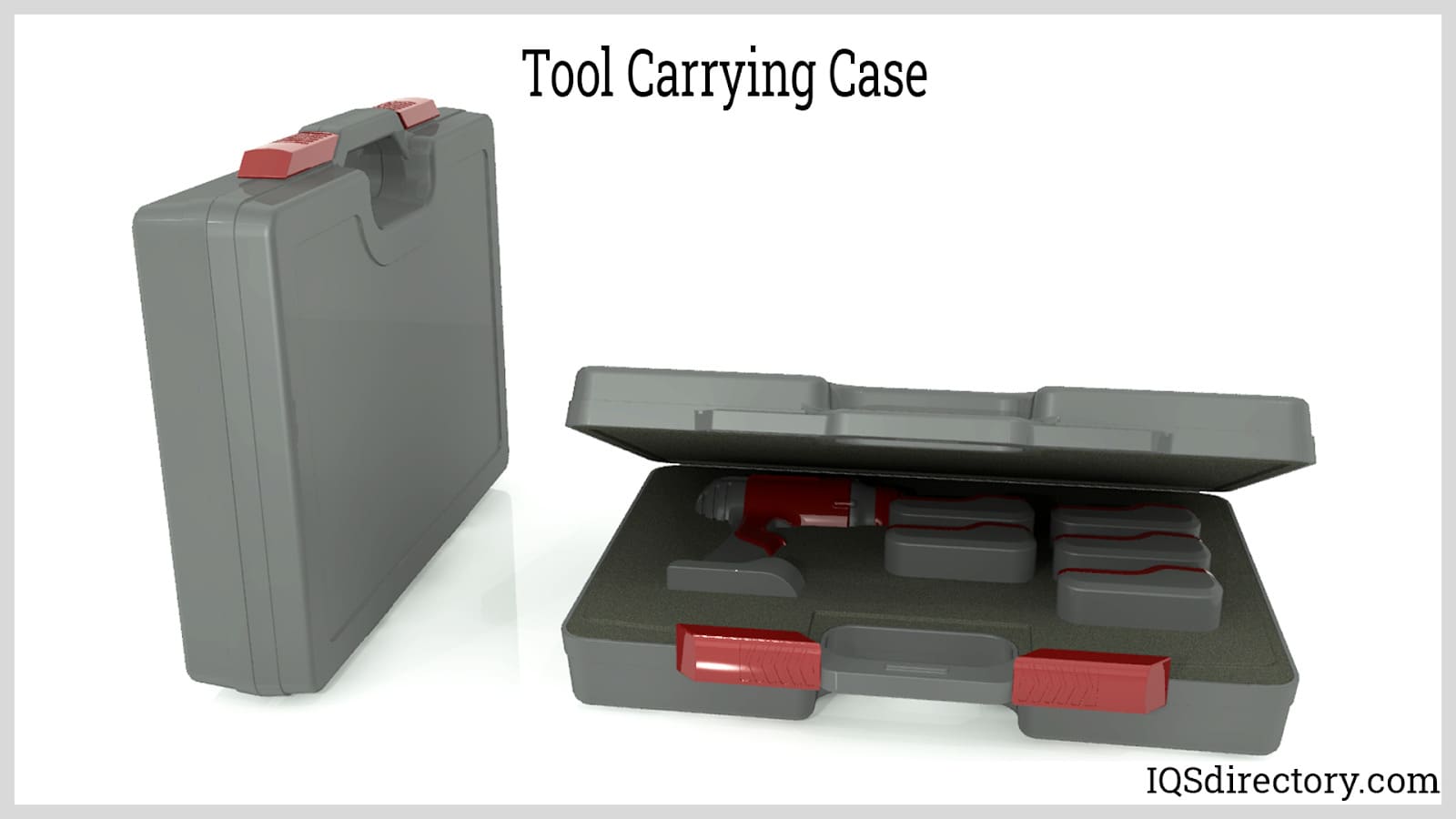 Tool carrying cases can be standard or custom designed in any size or configuration which protects the contents from moisture, salt spray, dust, and immersion.
Tool carrying cases can be standard or custom designed in any size or configuration which protects the contents from moisture, salt spray, dust, and immersion.
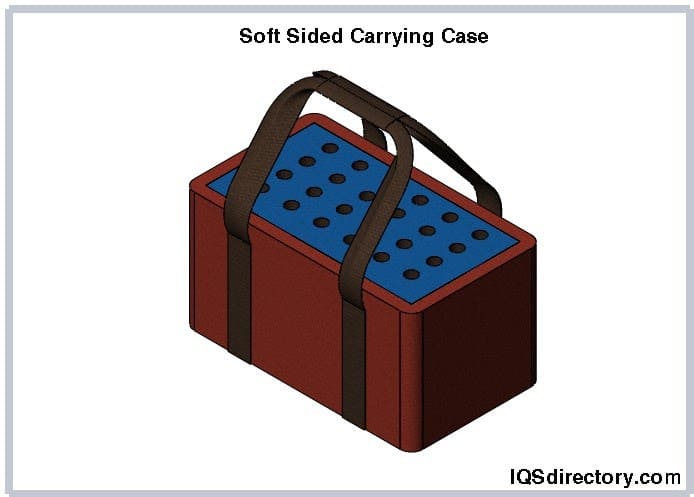 Soft sided cases that are made from fabrics, canvas, or vinyls making the sace water and dust resistant.
Soft sided cases that are made from fabrics, canvas, or vinyls making the sace water and dust resistant.
Hard Carrying Cases
- Shipping Containers
- The Air Transport Association (ATA) provides guidelines for shipping cases. ATA300 is the well known standard for airline shipping containers and is divided into 3 categories that designate the expected service rating. ATA cases have been manufactured and approved to meet the standards for category I. They are typically made from plywood, with an ABS plastic or polypropylene outer laminate shell, and a double aluminum angle frame, with nickel-plated steel corner reinforcement. They are generally equipped with wheels and multiple fold-away handles. The interiors may be open or furnished with custom foam inserts to stabilize the items inside.
- Trade Show Cases
- Usually ATA category I rated. They are used to ship and store goods for conventions and trade shows. When open, they may be transformed into tables, desks, or display racks of various kinds. They may have shelves, drawers, bins, or pegboards inside. They may be used individually or linked together for complex yet portable point of sale kiosks.
- Aluminum Cases
- May be purchased as standard models, or they may be custom manufactured to design specs. They may be virtually any size, deep or shallow, wide or long, and still remain lightweight and heavy duty. These shipping cases may be small enough to be used as an attaché case or large enough to carry wood or metal working machines with molded pockets for accessories. Aluminum cases may be collapsible for easy storage. They are often used as transit cases for delicate gear being shipped by air.
- Hard Plastic Protective Cases
- Inexpensive, lightweight, and durable. They may be blow molded, injection molded, or roto-molded into any shape and almost any size for custom cases and components.
- Blow Molding
- Begins with a piece of plastic called a parison, weighing slightly more than the finished product. The parison with a hole in one end, is clamped into a mold and heated to a malleable temperature. Compressed air is blown into the hole, expanding the plastic into the mold. Once the plastic has cooled and hardened, the mold is removed and the parts are ready for trimming and assembly. The blow mold case may be lined with foam or filled with product as is.
- Injection Molding
- The process of injecting molten plastic into a mold or die. When the plastic has cured, the mold or die is removed.
- Once the plastic case parts are manufactured, hinges, handles, latches, or locks may be installed on the outside. In some cases, a foam liner or solid foam interior may be added. Pluck foam, or pick and pluck foam is a solid sheet or block of foam made to be "cut out" to create voids for specific items. The manufacturer fills the case with foam and the consumer customizes it to specific needs.
- Rotary Molding
- Or roto-molding, combines the efficiency of blow molding with technology by using a revolving set of molds that move the parison from station to station so that multiple shaping aspects of the plastic may be accomplished in a mechanized combination of steps that makes the process of creating complex plastic cases fast and efficient.
- Molded Plastic Cases
- May have drawers, bins, pockets, or other plastic cases inside. They may have shallow, hinged tops that flip open to reveal telescoping trays. They may have adjustable compartments or fixed compartments in a wide variety of configurations.
- Military Use Cases
- Cases made for military purposes may be made from plastics, wood, or metal, but all must meet military specifications (mil specs) as set forth by government entities. Mil spec cases may be used to transport munitions, medical supplies, radio or sonar equipment, tools, food, or confidential materials.
Soft Carrying Cases
Some custom carrying cases are soft sided. These are typically sewn, but may be heat fused as well. They may have multiple pockets inside or outside. They may have a wood, plastic, or metal frame or be freestanding. They may have locking flaps, snaps, zippers, or hook and loop closures.
- Neoprene Cases
- Neoprene is used to make flexible, waterproof cases, often used for carrying electronics and photo equipment. The neoprene acts as an anti-static foam as well as a shock absorber. Neoprene fabric is black but may be laminated with a colored fabric.
- Nylon Cases
- Nylon is durable and inexpensive. It comes in a wide variety of colors and textures. It is made into tote bags of any reasonable size for tools, small equipment, and accessories. It may be embroidered, screen printed, or rubber stamped with a company name or team logo.
- Polyester Cases
- Polyester is not as durable as nylon, but may be used to manufacture the same designs as nylon cases at lower costs.
- PVC Cases
- PVC (polyvinyl chloride) can be woven, laminated, heat sealed, or embossed to create custom plastic carry cases that don't look like plastic, but maintain the same convenient traits. These cases are often made by laminating the PVC fabric on a fiberboard, which provides stiffness. They may offer a suitable, inexpensive alternative to leather.
- Leather Cases
- Some carry cases are still made from leather. While they are traditional, durable, and handsome, they are typically expensive and require maintenance that plastic or metal products do not. Leather is generally reserved for briefcases and small luggage pieces.
Other Carrying Case Types
- Catalog Cases
- Used by business executives and trade show exhibitors and use catalog cases because they can conveniently store a variety of items and files in their various compartments.
- Graphic Cases
- Designed to carry items such as maps and blueprints.
- Hazardous Materials Cases (HAZMAT)
- Specifically designed to transport potentially harmful materials such as gas, explosives and corrosives.
- Instrument Cases
- Used to protect and carry various instruments while they are being moved and can provide protection for a wide variety of industrial items during shipping and transportation.
- Panel Mount Cases
- Accommodate panels used to hold and separate field service equipment.
- Rack Mount Cases
- Contain a rack or shelf on which equipment can be stacked for accessible storage. Rack mount cases accommodate equipment such as computer networking application systems.
- Sample Cases
- Used before a product is officially released to the market, or when it is still new in stores, companies like to display samples that will spread awareness about the product and showcase its features. This is done in retail stores, at conferences, at trade shows, in business presentations or at other industry related events. To transport and display these samples, businesses use convenient sample cases.
- Tool Cases
- Designed to hold, protect and organize various tools and equipment.
Carrying Case Manufacturers
With so many custom plastics manufacturers, industrial sewing shops, and metal working shops, an appropriate carrying case should be available, either in standard or custom product lines. A good manufacturer will help choose the right materials for the job and create a design that is both attractive and functional.
Choose a manufacturer that understands the scope of the project and makes every effort to provide a satisfactory product at a reasonable price. If heavy duty cases are necessary, the manufacturer should not cut corners or offer lesser duty materials. Any special features, such as recessed handles, wheels, or certain types of hinges, should be figured into the design. Labels, logos, or other printed material should be discussed ahead of time and calculated into the overall cost.
Always look for a manufacturer who will deliver the finished product in a timely manner. They should provide quality materials, good workmanship, and be conscientious of the impact their business has on the community and the environment. You can return to the top of this page to find a convenient list of manufacturers of carrying cases of many different types.
Carrying Case Terms
- Acrylonitrile-Butadiene-Styrene (ABS)
- A strong plastic used in a variety of industrial applications, such as an outer laminate for shipping cases.
- Angle
- An outer corner covering made of aluminum that is on shipping cases.
- Anti-Static Foam
- Specially treated, non-conductive polyfoam or polyethylene foam material that is ideal for magnetic media cushioning. Useful in creating a carry case for transporting any sensitive computer equipment.
- Base
- The lower part of the case that would sit flat during loading.
- Blocking
- Using wood or foam to support encased items in order to increase the effectiveness of case interiors.
- Casters
- Rotating wheels set in a metal frame that provide mobility to heavy objects, such as furniture or electronic equipment.
- Cavity Cut-Out
- A space that is usually cut out directly beneath the encased item, which is often used for storage of cables, owners manuals and other accessories.
- Coupler
- A device utilized for attaching several cases together.
- Cubed Foam
- Also referred to as “diced foam,” it is one-inch cubes of polyester foam, of which only the corners are left attached to make it easy to remove in order to attain the desired space for an encased object.
- Electrostatic Discharge
- The release of electrical energy usually caused by the shift of electrons from one object to another as the objects come into contact with and separate from one another.
- Embossing
- The application of heat and pressure to create a raised design or logo.
- F-B
- A shortened term meaning “front to back,” typically referring to depth.
- Foil Embossing
- The simultaneous use of embossing and foil stamping.
- Foil Stamping
- The application of a stamp pressed in foil to a surface, in which the foil transfers the outline to the surface.
- G-factor
- Measurement of the durability of an item.
- Hand Slot
- A slot cut out of the foam specifically to aid in the removal of the item from the case.
- L-R
- A term meaning “left to right,” typically referring to width.
- Load Capacity
- The maximum amount of weight a case can efficiently handle.
- Neoprene
- Artificial rubber used in a wide array of industrial applications that resists wear and tear from chemicals, temperature and hazardous conditions.
- Polyethylene (PE)
- Light, durable plastic material that is resistant to stain from chemicals or other fluids and is not affected by temperature.
- Polymer
- A compound consisting of multi-linked units of elements, such as hydrogen or silicon.
- Polypropylene (PP)
- A strong polymer that functions as both a fiber and a plastic and is more durable but less common than polyethylene.
- Skid
- Damage incurred from dragging, etc., during transportation.
- Skid Runners
- Apparatus applied to a case to protect against skid damage.